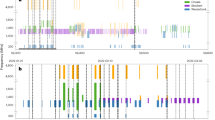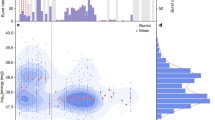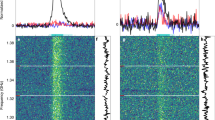Abstract
Despite considerable efforts over the past decade, only 34 fast radio bursts—intense bursts of radio emission from beyond our Galaxy—have been reported1,2. Attempts to understand the population as a whole have been hindered by the highly heterogeneous nature of the searches, which have been conducted with telescopes of different sensitivities, at a range of radio frequencies, and in environments corrupted by different levels of radio-frequency interference from human activity. Searches have been further complicated by uncertain burst positions and brightnesses—a consequence of the transient nature of the sources and the poor angular resolution of the detecting instruments. The discovery of repeating bursts from one source3, and its subsequent localization4 to a dwarf galaxy at a distance of 3.7 billion light years, confirmed that the population of fast radio bursts is located at cosmological distances. However, the nature of the emission remains elusive. Here we report a well controlled, wide-field radio survey for these bursts. We found 20, none of which repeated during follow-up observations between 185–1,097 hours after the initial detections. The sample includes both the nearest and the most energetic bursts detected so far. The survey demonstrates that there is a relationship between burst dispersion and brightness and that the high-fluence bursts are the nearby analogues of the more distant events found in higher-sensitivity, narrower-field surveys5.
This is a preview of subscription content, access via your institution
Access options
Access Nature and 54 other Nature Portfolio journals
Get Nature+, our best-value online-access subscription
$29.99 / 30 days
cancel any time
Subscribe to this journal
Receive 51 print issues and online access
$199.00 per year
only $3.90 per issue
Buy this article
- Purchase on SpringerLink
- Instant access to full article PDF
Prices may be subject to local taxes which are calculated during checkout


Similar content being viewed by others
Data availability
Raw data files (totalling 1 PB) are archived on tape at the Pawsey Superconducting Centre. Cut-outs of the raw data, in pulsar filterbank format (http://sigproc.sourceforge.net), and posterior localization regions, are available on the CSIRO data access portal through https://doi.org/10.25919/5b6ae6b515850. Other data products are available on request from R.M.S.
References
Lorimer, D. R., Bailes, M., McLaughlin, M. A., Narkevic, D. J. & Crawford, F. A bright millisecond radio burst of extragalactic origin. Science 318, 777–780 (2007).
Petroff, E. et al. FRBCAT: the fast radio burst catalogue. Publ. Astron. Soc. Aust. 33, e045 (2016).
Spitler, L. G. et al. A repeating fast radio burst. Nature 531, 202–205 (2016).
Chatterjee, S. et al. A direct localization of a fast radio burst and its host. Nature 541, 58–61 (2017).
Champion, D. J. et al. Five new fast radio bursts from the HTRU high-latitude survey at Parkes: first evidence for two-component bursts. Mon. Not. R. Astron. Soc. 460, L30–L34 (2016).
McConnell, D. et al. The Australian Square Kilometre Array Pathfinder: performance of the Boolardy engineering test array. Publ. Astron. Soc. Aust. 33, e042 (2016).
Bannister, K. W. et al. The cetection of an extremely bright fast radio burst in a phased array feed survey. Astrophys. J. 841, L12 (2017).
Macquart, J.-P. & Johnston, S. On the paucity of fast radio bursts at low Galactic latitudes. Mon. Not. R. Astron. Soc. 451, 3278–3286 (2015).
Xu, J. & Han, J. L. Extragalactic dispersion measures of fast radio bursts. Res. Astron. Astrophys. 15, 1629 (2015).
Inoue, S. Probing the cosmic reionization history and local environment of gamma-ray bursts through radio dispersion. Mon. Not. R. Astron. Soc. 348, 999–1008 (2004).
McQuinn, M. Locating the “missing” baryons with extragalactic dispersion measure estimates. Astrophys. J. 780, L33 (2014).
Yao, J. M., Manchester, R. N. & Wang, N. A new electron-density model for estimation of pulsar and FRB distances. Astrophys. J. 835, 29 (2017).
Meyer, M. J. et al. The HIPASS catalogue—I. Data presentation. Mon. Not. R. Astron. Soc. 350, 1195–1209 (2004).
Jones, D. H. et al. The 6dF galaxy survey: final redshift release (DR3) and southern large-scale structures. Mon. Not. R. Astron. Soc. 399, 683–698 (2009).
Cordes, J. M. et al. Lensing of fast radio bursts by plasma structures in host galaxies. Astrophys. J. 842, 35 (2017).
Oslowski, S. et al. Real-time detection of an extremely high signal-to-noise ratio fast radio burst during observations of PSR J2124–3358. Astron. Telegr. 11385 (2018).
Ravi, V. et al. The magnetic field and turbulence of the cosmic web measured using a brilliant fast radio burst. Science 354, 1249–1252 (2016).
Ravi, V. The observed properties of fast radio bursts. Mon. Not. R. Astron. Soc. (in the press); preprint at https://arxiv.org/abs/1710.08026 (2017).
Lambert, H. C. & Rickett, B. J. On the theory of pulse propagation and two-frequency field statistics in irregular interstellar plasmas. Astrophys. J. 517, 299–317 (1999).
Masui, K. et al. Dense magnetized plasma associated with a fast radio burst. Nature 528, 523–525 (2015).
Farah, W. et al. FRB microstructure revealed by the real-time detection of FRB170827. Mon. Not. R. Astron. Soc. (in the press); preprint at https://arxiv.org/abs/1803.05697 (2018).
Oppermann, N., Connor, L. D. & Pen, U.-L. The Euclidean distribution of fast radio bursts. Mon. Not. R. Astron. Soc. 461, 984–987 (2016).
Macquart, J.-P. & Ekers, R. D. Fast radio burst event rate counts—I. Interpreting the observations. Mon. Not. R. Astron. Soc. 474, 1900–1908 (2018).
von Hoerner, S. Radio source counts and cosmology. Astrophys. J. 186, 741–766 (1973).
Bhandari, S. et al. The SUrvey for pulsars and extragalactic radio bursts—II. New FRB discoveries and their follow-up. Mon. Not. R. Astron. Soc. 475, 1427–1446 (2018).
Law, C. J. et al. A multi-telescope campaign on FRB 121102: implications for the FRB Population. Astrophys. J. 850, 76 (2017).
Michilli, D. et al. An extreme magneto-ionic environment associated with the fast radio burst source FRB 121102. Nature 553, 182–185 (2018).
Keane, E. F. et al. The host galaxy of a fast radio burst. Nature 530, 453–456 (2016).
Scholz, P. et al. The repeating fast radio burst FRB 121102: multi-wavelength observations and additional bursts. Astrophys. J. 833, 177 (2016).
Macquart, J. P. et al. Fast transients at cosmological distances with the SKA. Adv. Astrophys. Square Kilometre Array (AASKA14) Proc. Sci. 215, 55 (2015).
Acknowledgements
We thank the Australia Telescope National Facility (ATNF) engineering and technical staff for their help in supporting these observations, and especially thank the staff of the Murchison Radio-astronomy observatory. We thank C. Flynn, P. Edwards, N. Tejos and V. McIntyre for comments on the manuscript, and members of the Commensal Real-time ASKAP Fast Transients (CRAFT) team for discussions. We thank the Murchison Widefield Array (MWA) principal engineer, R. Wayth, for access to the Galaxy supercomputer graphics processing units (GPU) cluster. R.M.S. and S.O. acknowledge Australian Research Council (ARC) grant FL150100148. R.M.S. also acknowledges support through ARC grant CE170100004. G.G. acknowledges support through a Commonwealth Scientific and Industrial Research Organisation (CSIRO) Office of the Chief Executive (OCE) postdoctoral fellowship. Parts of this research were conducted by the ARC Centre of Excellence for All-Sky Astrophysics (CAASTRO; grant CE110001020). This research was also supported by the ARC through grant DP18010085. The Australian SKA Pathfinder and Parkes radio telescopes are part of the ATNF, which is managed by the CSIRO. Operation of ASKAP is funded by the Australian Government with support from the National Collaborative Research Infrastructure Strategy. ASKAP uses the resources of the Pawsey Supercomputing Centre. Establishment of ASKAP, the Murchison Radio-astronomy Observatory and the Pawsey Supercomputing Centre are initiatives of the Australian Government, with support from the Government of Western Australia and the Science and Industry Endowment Fund. We acknowledge the Wajarri Yamatji people as the traditional owners of the Observatory site. This research has made use of the National Aeronautics and Space Administration (NASA)/Infrared Processing and Analysis Center (IPAC) Extragalactic Database (NED), which is operated by the Jet Propulsion Laboratory, California Institute of Technology, under contract with NASA.
Reviewer information
Nature thanks J. Cordes, D. Lorimer and S. Ransom for their contribution to the peer review of this work.
Author information
Authors and Affiliations
Contributions
K.W.B. led the development of the CRAFT data-acquisition system. R.M.S., J.-P.M. and K.W.B. designed the survey. R.M.S., J-.P.M., K.W.B. and R.D.E drafted the manuscript. R.M.S. and K.W.B. conducted the observations, with assistance from A.W.H. and M.A.V. K.W.B. designed the search code. K.W.B., C.W.J., S.O., H.Q. and M.S. verified survey efficiency. R.M.S., with discussions with J.R.A., implemented the FRB localization algorithm. R.M.S., J.-P.M. and R.D.E interpreted the fluence and dispersion-measure distributions of the population. C.W.J., S.O. and J.-P.M. interpreted the nonrepetition of the ASKAP sample and compared it with the repeating FRB. R.M.S. and S.O. led searches for follow-up bursts at Parkes. E.M.S. studied the optical fields surrounding the detected FRBs. R.J.B., M.B., A.J.B., J.D.B., A.P.C., C.H., A.W.H., M.L., M.M., D.M., M.A.P, E.R.T., J.T., M.A.V. and M.T.W. contributed to development and commissioning of the CRAFT observing mode. J.R.A., C.S.A., M.E.B., J.D.C., G.G., G.H. and C.J.R. contributed to ASKAP commissioning and early science.
Corresponding authors
Ethics declarations
Competing interests
The authors declare no competing interests.
Additional information
Publisher’s note: Springer Nature remains neutral with regard to jurisdictional claims in published maps and institutional affiliations.
Supplementary information
Supplementary Information
This file contains Supplementary Information, including additional references, Supplementary Tables 1-19 and Supplementary Figures 1-28.
Rights and permissions
About this article
Cite this article
Shannon, R.M., Macquart, JP., Bannister, K.W. et al. The dispersion–brightness relation for fast radio bursts from a wide-field survey. Nature 562, 386–390 (2018). https://doi.org/10.1038/s41586-018-0588-y
Received:
Accepted:
Published:
Issue Date:
DOI: https://doi.org/10.1038/s41586-018-0588-y
Keywords
This article is cited by
-
A link between repeating and non-repeating fast radio bursts through their energy distributions
Nature Astronomy (2024)
-
An assessment of the association between a fast radio burst and binary neutron star merger
Nature Astronomy (2023)
-
A multi-band atomic candle with microwave-dressed Rydberg atoms
Frontiers of Physics (2023)
-
Cosmology with fast radio bursts in the era of SKA
Science China Physics, Mechanics & Astronomy (2023)
-
The observed impact of galaxy halo gas on fast radio bursts
Nature Astronomy (2022)



